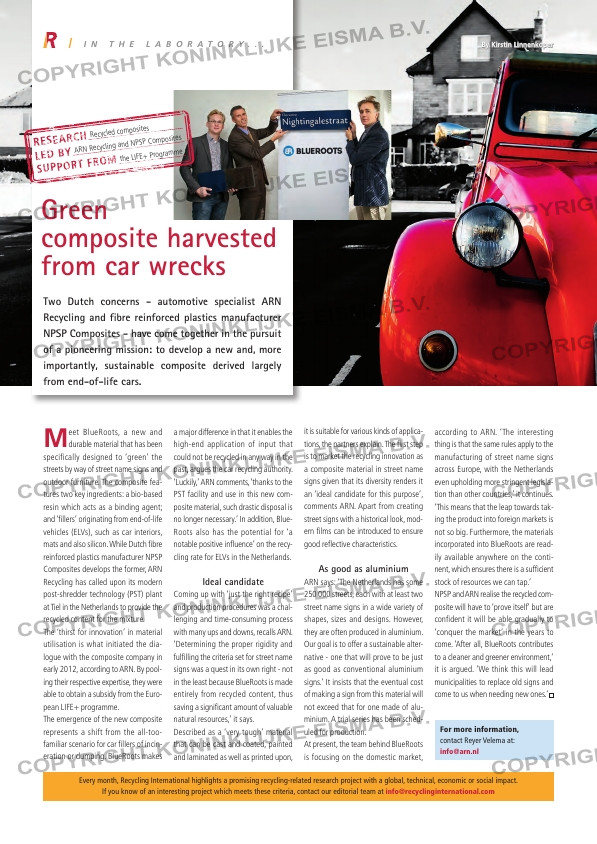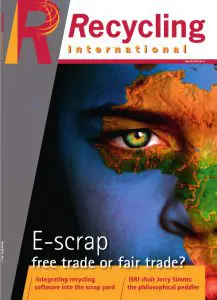Page 91 from: March 2013

I N T H E L A B O R A T O R Y . . .
according to ARN. ‘The interesting
thing is that the same rules apply to the
manufacturing of street name signs
across Europe, with the Netherlands
even upholding more stringent legisla-
tion than other countries,’ it continues.
‘This means that the leap towards tak-
ing the product into foreign markets is
not so big. Furthermore, the materials
incorporated into BlueRoots are read-
ily available anywhere on the conti-
nent, which ensures there is a suffi cient
stock of resources we can tap.’
NPSP and ARN realise the recycled com-
posite will have to ‘prove itself’ but are
confi dent it will be able gradually to
‘conquer the market’ in the years to
come. ‘After all, BlueRoots contributes
to a cleaner and greener environment,’
it is argued. ‘We think this will lead
municipalities to replace old signs and
come to us when needing new ones.’
Meet BlueRoots, a new and durable material that has been
specifically designed to ‘green’ the
streets by way of street name signs and
outdoor furniture. The composite fea-
tures two key ingredients: a bio-based
resin which acts as a binding agent;
and ‘fi llers’ originating from end-of-life
vehicles (ELVs), such as car interiors,
mats and also silicon. While Dutch fi bre
reinforced plastics manufacturer NPSP
Composites develops the former, ARN
Recycling has called upon its modern
post-shredder technology (PST) plant
at Tiel in the Netherlands to provide the
recycled content for the mixture.
The ‘thirst for innovation’ in material
utilisation is what initiated the dia-
logue with the composite company in
early 2012, according to ARN. By pool-
ing their respective expertise, they were
able to obtain a subsidy from the Euro-
pean LIFE+ programme.
The emergence of the new composite
represents a shift from the all-too-
familiar scenario for car fi llers of incin-
eration or dumping. BlueRoots makes
it is suitable for various kinds of applica-
tions, the partners explain. The fi rst step
is to market the recycling innovation as
a composite material in street name
signs given that its diversity renders it
an ‘ideal candidate for this purpose’,
comments ARN. Apart from creating
street signs with a historical look, mod-
ern fi lms can be introduced to ensure
good refl ective characteristics.
As good as aluminium
ARN says: ‘The Netherlands has some
250 000 streets, each with at least two
street name signs in a wide variety of
shapes, sizes and designs. However,
they are often produced in aluminium.
Our goal is to offer a sustainable alter-
native – one that will prove to be just
as good as conventional aluminium
signs.’ It insists that the eventual cost
of making a sign from this material will
not exceed that for one made of alu-
minium. A trial series has been sched-
uled for production.
At present, the team behind BlueRoots
is focusing on the domestic market,
a major difference in that it enables the
high-end application of input that
could not be recycled in any way in the
past, argues the car recycling authority.
‘Luckily,’ ARN comments, ‘thanks to the
PST facility and use in this new com-
posite material, such drastic disposal is
no longer necessary.’ In addition, Blue-
Roots also has the potential for ‘a
notable positive infl uence’ on the recy-
cling rate for ELVs in the Netherlands.
Ideal candidate
Coming up with ‘just the right recipe’
and production procedures was a chal-
lenging and time-consuming process
with many ups and downs, recalls ARN.
‘Determining the proper rigidity and
fulfi lling the criteria set for street name
signs was a quest in its own right – not
in the least because BlueRoots is made
entirely from recycled content, thus
saving a signifi cant amount of valuable
natural resources,’ it says.
Described as a ‘very tough’ material
that can be cast and coated, painted
and laminated as well as printed upon,
Green
composite harvested
from car wrecks
Two Dutch concerns – automotive specialist ARN
Recycling and fibre reinforced plastics manufacturer
NPSP Composites – have come together in the pursuit
of a pioneering mission: to develop a new and, more
importantly, sustainable composite derived largely
from end-of-life cars.
By Kirstin Linnenkoper
Every month, Recycling International highlights a promising recycling-related research project with a global, technical, economic or social impact.
If you know of an interesting project which meets these criteria, contact our editorial team at [email protected]
For more information,
contact Reyer Velema at:
[email protected]
RESEARCH
LED BY
SUPPORT
FROM
Recycled com
posites
ARN Recycli
ng and NPSP
Composites
the LIFE+ Pr
ogramme
RI_2-IntheLab.indd 91 06-03-13 08:57



